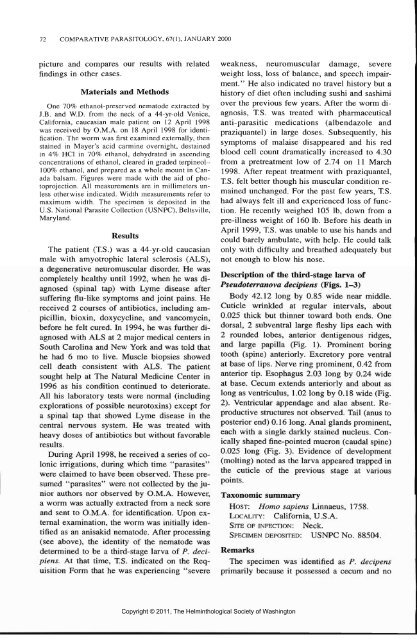Comparative Parasitology 67(1) 2000 - Peru State College
Comparative Parasitology 67(1) 2000 - Peru State College
Comparative Parasitology 67(1) 2000 - Peru State College
You also want an ePaper? Increase the reach of your titles
YUMPU automatically turns print PDFs into web optimized ePapers that Google loves.
72 COMPARATIVE PARASITOLOGY, <strong>67</strong>(1), JANUARY <strong>2000</strong><br />
picture and compares our results with related<br />
findings in other cases.<br />
Materials and Methods<br />
One 70% ethanol-preserved nematode extracted by<br />
J.B. and W.D. from the neck of a 44-yr-old Venice,<br />
California, Caucasian male patient on 12 April 1998<br />
was received by O.M.A. on 18 April 1998 for identification.<br />
The worm was first examined externally, then<br />
stained in Mayer's acid carmine overnight, destained<br />
in 4% HC1 in 70% ethanol, dehydrated in ascending<br />
concentrations of ethanol, cleared in graded terpineol-<br />
100% ethanol, and prepared as a whole mount in Canada<br />
balsam. Figures were made with the aid of photoprojection.<br />
All measurements are in millimeters unless<br />
otherwise indicated. Width measurements refer to<br />
maximum width. The specimen is deposited in the<br />
U.S. National Parasite Collection (USNPC), Beltsville,<br />
Maryland.<br />
Results<br />
The patient (T.S.) was a 44-yr-old Caucasian<br />
male with amyotrophic lateral sclerosis (ALS),<br />
a degenerative neuromuscular disorder. He was<br />
completely healthy until 1992, when he was diagnosed<br />
(spinal tap) with Lyme disease after<br />
suffering flu-like symptoms and joint pains. He<br />
received 2 courses of antibiotics, including ampicillin,<br />
bioxin, doxycycline, and vancomycin,<br />
before he felt cured. In 1994, he was further diagnosed<br />
with ALS at 2 major medical centers in<br />
South Carolina and New York and was told that<br />
he had 6 mo to live. Muscle biopsies showed<br />
cell death consistent with ALS. The patient<br />
sought help at The Natural Medicine Center in<br />
1996 as his condition continued to deteriorate.<br />
All his laboratory tests were normal (including<br />
explorations of possible neurotoxins) except for<br />
a spinal tap that showed Lyme disease in the<br />
central nervous system. He was treated with<br />
heavy doses of antibiotics but without favorable<br />
results.<br />
During April 1998, he received a series of co-<br />
Ionic irrigations, during which time "parasites"<br />
were claimed to have been observed. These presumed<br />
"parasites" were not collected by the junior<br />
authors nor observed by O.M.A. However,<br />
a worm was actually extracted from a neck sore<br />
and sent to O.M.A. for identification. Upon external<br />
examination, the worm was initially identified<br />
as an anisakid nematode. After processing<br />
(see above), the identity of the nematode was<br />
determined to be a third-stage larva of P. decipiens.<br />
At that time, T.S. indicated on the Requisition<br />
Form that he was experiencing "severe<br />
Copyright © 2011, The Helminthological Society of Washington<br />
weakness, neuromuscular damage, severe<br />
weight loss, loss of balance, and speech impairment."<br />
He also indicated no travel history but a<br />
history of diet often including sushi and sashimi<br />
over the previous few years. After the worm diagnosis,<br />
T.S. was treated with pharmaceutical<br />
anti-parasitic medications (albendazole and<br />
praziquantel) in large doses. Subsequently, his<br />
symptoms of malaise disappeared and his red<br />
blood cell count dramatically increased to 4.30<br />
from a pretreatment low of 2.74 on 11 March<br />
1998. After repeat treatment with praziquantel,<br />
T.S. felt better though his muscular condition remained<br />
unchanged. For the past few years, T.S.<br />
had always felt ill and experienced loss of function.<br />
He recently weighed 105 Ib, down from a<br />
pre-illness weight of 160 Ib. Before his death in<br />
April 1999, T.S. was unable to use his hands and<br />
could barely ambulate, with help. He could talk<br />
only with difficulty and breathed adequately but<br />
not enough to blow his nose.<br />
Description of the third-stage larva of<br />
Pseudoterranova decipiens (Figs. 1-3)<br />
Body 42.12 long by 0.85 wide near middle.<br />
Cuticle wrinkled at regular intervals, about<br />
0.025 thick but thinner toward both ends. One<br />
dorsal, 2 subventral large fleshy lips each with<br />
2 rounded lobes, anterior dentigenous ridges,<br />
and large papilla (Fig. 1). Prominent boring<br />
tooth (spine) anteriorly. Excretory pore ventral<br />
at base of lips. Nerve ring prominent, 0.42 from<br />
anterior tip. Esophagus 2.03 long by 0.24 wide<br />
at base. Cecum extends anteriorly and about as<br />
long as ventriculus, 1.02 long by 0.18 wide (Fig.<br />
2). Ventricular appendage and alae absent. Reproductive<br />
structures not observed. Tail (anus to<br />
posterior end) 0.16 long. Anal glands prominent,<br />
each with a single darkly stained nucleus. Conically<br />
shaped fine-pointed mucron (caudal spine)<br />
0.025 long (Fig. 3). Evidence of development<br />
(molting) noted as the larva appeared trapped in<br />
the cuticle of the previous stage at various<br />
points.<br />
Taxonomic summary<br />
HOST: Homo sapiens Linnaeus, 1758.<br />
LOCALITY: California, U.S.A.<br />
SITE OF INFECTION: Neck.<br />
SPECIMEN DEPOSITED: USNPC No. 88504.<br />
Remarks<br />
The specimen was identified as P. decipens<br />
primarily because it possessed a cecum and no
















